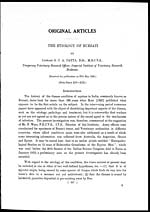Medicine - Veterinary > Veterinary colleges and laboratories > Indian journal of veterinary science and animal husbandry > Volume 3, 1933 > Original articles > Etiology of bursati
(276) Page 218
Download files
Individual page:
Thumbnail gallery: Grid view | List view

218 THE INDIAN JOURNAL OF VETERINARY SCIENCE AND ANIMAL HUSBANDRY [III, III.
Of these two theories, the former is the older, being first suggested by Jackson
[1842], but actual experimental data in support of this were only later put forward
by Smith [1884], Steel [1885], Burke [1892], and finally by Holmes [1914]. For
the purposes of this article, the work of the latter two workers only need be
recounted. In attempting to prove that this condition was an epithelioma, Burke
[1880-1888] most vehimently criticised the mycotic theory but again a few years
later [1892] he was emphatic that the disease was a form of actinomycosis. Holmes'
view was that it was a form of sporothricosis resembling a disease of the horse and
the mule described by Carougeau [1909] in Madagascar, since a chalky white growth,
resembling closely the fungus Sporotrichum minutissimum was repeatedly obtained
in culture by him from Bursati tumours, kunkurs, and direct from the blood of
horses affected with the disease. Experimental inoculations carried out by him
with cultures of this fungus yielded only negative results. As a result of a prelimi-
nary study of the condition in Calcutta in 1929, Datta [1931] also recorded certain
experimental data from which it appeared that the actinomycotic theory was the
more plausible, since a strain of actinomyces, resembling Holmes' culture in
morphology, was isolated without difficulty from Bursati lesions, and because the
disease could not be transmitted experimentally through the intervention of flies,
which were allowed free access between affected subjects and healthy equines, with
unprotected cutaneous wounds in various parts of the body. It may be noted that
another similar condition designated as ' leaches' affecting equines in America,
is considered by Theobald Smith [1893-94] as being caused by a fungus, similar
to that concerned in "Madura foot of India ", the yellow granules of the equine
disease being identical with what are called ' Sulphur granules' of actinomycosis.
With regard to Holmes' work, one cannot overlook the fact that he does not put
forward any mycological data on which the identification was based, for, there
is nothing in his description to indicate that the characteristic lateral spore-clusters
were observed with his fungus. Further if his theory were correct, one should
expect to find nodules spreading along the course of lymphatics with lymphangitis
and lymphadenitis, but it is known that these do not constitute the clinical features
of Bursati.
The helminthic theory was first put forward by Lingard [1905], who referred
to the presence of a " felted aggregation of nematode worms " in the inner layer
of a Bursati sore but, as Holmes has pointed out, " there is an indefiniteness about
Lingard's statements which fail to make clear whether personal observations were
being recorded or deduction made from the literature of other writers on the
subject". Further in questioning the identity of Lingard's " felted aggregation ",
Gaiger [1915] has adduced evidence to show that they represented, in reality,
Set display mode to: Large image | Zoom image | Transcription
Images and transcriptions on this page, including medium image downloads, may be used under the Creative Commons Attribution 4.0 International Licence unless otherwise stated. ![]()
| Permanent URL | https://digital.nls.uk/75230302 |
|---|
| Description | Covers articles from 1933. |
|---|




